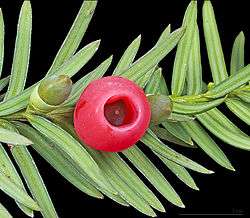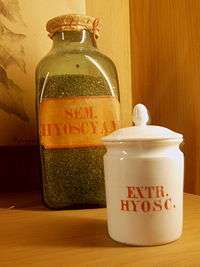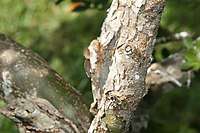Hebenon
Hebenon (or hebona) is a botanical substance described in William Shakespeare's tragic play Hamlet. The identity and nature of the poison has been a source of speculation for centuries.
_MET_DP860043.jpg)
Shakespeare's Usage
Hebenon is the agent of death in Hamlet's father's murder; it sets in motion the events of the play. It is spelled hebona in the Quartos and hebenon in the Folios. This is the only mention of hebona or hebenon in any of Shakespeare’s plays.
- Upon my secure hour thy uncle stole,
- With juice of cursed hebenon in a vial,
- And in the porches of my ears did pour
- The leperous distilment; whose effect
- Holds such an enmity with blood of man
- That, swift as quicksilver, it courses through
- The natural gates and alleys of the body;
- And with a sudden vigour it doth posset
- And curd, like eager droppings into milk,
- The thin and wholesome blood; so did it mine;
- And a most instant tetter bark'd about,
- Most lazar-like, with vile and loathsome crust
- All my smooth body.
- Thus was I, sleeping, by a brother's hand,
- Of life, of crown, of queen, at once dispatch'd:
- -Ghost (King Hamlet, Hamlet's Father) spoken to Hamlet
- [Act I, scene 5]
- -Ghost (King Hamlet, Hamlet's Father) spoken to Hamlet
Identity of the poison
Writers from Shakespeare's time to the present have speculated about the identity of hebenon.
It may be different from hemlock, as hemlock is explicitly mentioned in several other writings of his (including King Lear, Macbeth and Henry V). In favor of it being yew are the familiarity of yew as a poison and the similarity in symptoms. Edmund Spenser wrote of "the deadly heben bow"[1] ("heben" being a word for ebony, from Latin hebenus). In favor of ebony (specifically, guaiac) is the fact that ebony was sometimes written with an h, but arguing against it is the low toxicity of guaiac.[2] In favour of henbane is its toxic nature and the possible origin of hebenon as metathesis from henbane.[3] Other authors question whether there is sufficient evidence to resolve the issue, or even whether Shakespeare's attention to botany and pharmacology was sufficient to say he meant a specific plant.[4]
References
- Seymour, Mirinda (2000, May 20). "Country & Garden: Herbs - no 22: Henbane", The Independent. ProQuest document ID 311652931
- John George Robertson; G.C. Moore Smith; Charles Jasper Sisson (1920). The Modern Language Review: A Quarterly Journal Devoted to the Study of Medieval and Modern Literature and Philology, Volume 15. Modern Humanities Research Association, U of Cambridge Press (hardcover reprint, Repressed Publishing LLC, 2012; paperback reprint, U of Michigan Press, 1905). pp. 304–306. ASIN B007IP0BS6.
- Georgieff, Dimitar (11 August 2018). "Shakespeare's hapax for the plant hebenon in the play Hamlet" – via ResearchGate. Cite journal requires
|journal=(help) - Anatoly Liberman; J. Lawrence Mitchell (2008). An Analytic Dictionary of English Etymology: An Introduction. U of Minnesota Press. pp. 110–111. ISBN 978-0-8166-5272-3.
Further reading
- Huxtable, Ryan J. "On the nature of Shakespeare's cursed hebona." Perspectives in Biology and Medicine Winter 1993: 262+. Academic OneFile. 10 Oct. 2012.
- G. H. "Shakespeare's Hebona" Pharmacy in History Vol. 35, No. 3 (1993), p. 137 DOI: 10.2307/41111539
- Harrison, Jr., Thomas P. "Shakespeare's 'Hebenon' Again" The Modern Language Review Vol. 40, No. 4, Oct., 1945 p. 310-311
- Montgomery, Marshall. ""Cursed Hebenon" (Or "Hebona")" The Modern Language Review Vol. 15, No. 3, Jul., 1920 p. 304-306
- Simpson, R. R. "Shakespeare on the Ear, Nose and Throat" The Journal of Laryngology & Otology Volume64 Issue06 June 1950, pp 342–352
- Tabor, Edward. "Plant poisons in Shakespeare" Economic Botany 1970, Volume 24, Number 1, Pages 81–94
External links
- Botanical survey of Shakespeare at the Wayback Machine (archived November 22, 2008) by K.N. Rao, Professor of Botany in Chennai, India



